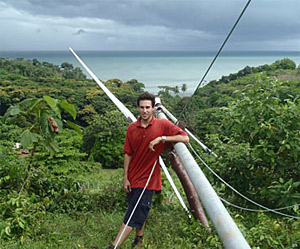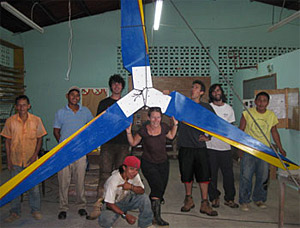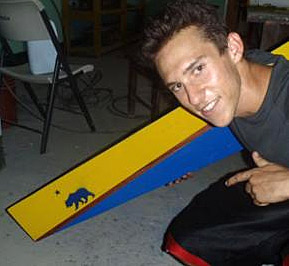Field report from Nicaragua

ME graduate student David Olmos repairing a wind turbine in Monkey Point, Nicaragua, as part of a summer internship with the Cal Energy Corps. (Photo by Guillaume Craig.)
David Olmos (B.S.’11 ME) spent his summer working with the nonprofit organization blueEnergy in Central America as part of an internship with Cal Energy Corps, a program launched in spring 2011 to help develop sustainable energy and climate solutions around the world. Now a graduate student in mechanical engineering, Olmos sent this report from the field:
BLUEFIELDS, NICARAGUA — My primary objective is to design and build a 17-foot wind turbine prototype. Although blueEnergy has fabricated 12- and 14-foot turbines, I am responsible for creating a new prototype capable of harvesting more energy. I already had a strong background in aerodynamics and integration of wind energy into the grid; however, these turbines are for remote villages without an electrical grid, and efficiency is not as much of a concern as reliability. The obstacles in this environment require me to apply engineering techniques in new ways.

The Cal/Nicaraguan team display the final wind turbine assembly with its Cal/Nicaraguan colors. (Photo by Marcy Ostberg.)
The first step in building the blades was to scale up the dimensions of current blade designs. Sawing and fitting the 2x4s together was like a jigsaw puzzle, trying to match the concavity so that they are flush without excessive strains on the epoxy resin. After planing the wood and tapering the blade, remaining chunks were chipped away with a machete and sanded down with a grinder. (This is where the privilege of having a band saw would have been useful.) Carving the pitch on the front of the blade was more of a challenge, as the angle of the blade changes along the length, but the change in pitch is necessary to optimize power harvesting. I have also been designing an alternative way to assemble and disassemble the blades to facilitate easier transport and repair of this larger turbine.

The Cal bear remains a part of the sustainable infrastructure project initiated by Berkeley Engineering students this summer. (Photo by Marcy Ostberg.)
I have come to realize how much of a difference a few watts of power can make in people’s lives—by providing light for medical operations and access to refrigerated vaccines and radio communication. I also realize that there is a great opportunity to introduce renewable energy into the developing world because there is no existing infrastructure to overcome. If a sustainable infrastructure can be implemented from the start, these communities are likely to have a much more successful future.
